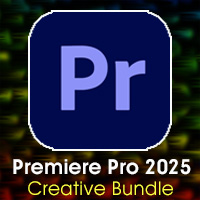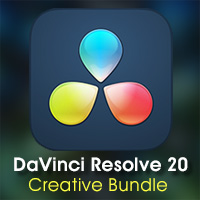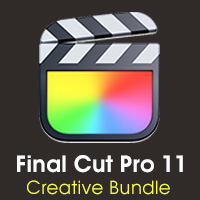"WITHOUT QUESTION!! Larry Jordan is the go to for all video editing & more! Mr. Jordan has decades of experience and knows what we need. He’s not only teaching software, Larry teaches knowledge & experience: Wisdom!" - Oscar Bustamante, Fluid Vision Inc.
Featured Products
-
Sale!

Creative Bundle: Adobe Premiere Pro 2025
Original price was: $117.73.$74.29Current price is: $74.29. Select -

Larry Jordan Gift Card
Select -
Sale!

Creative Bundle: DaVinci Resolve 20
Original price was: $119.70.$79.99Current price is: $79.99. Select -
Sale!

Creative Bundle: Apple Final Cut Pro 11
Original price was: $132.71.$88.92Current price is: $88.92. Select
In this online training, host Larry Jordan shows you how to create custom effects in Motion that you can modify in Final Cut. Motion effects can be “published” to Final Cut Pro X, which means it can share the effect AND share the controls for the effect. This sharing is done using publishing and rigs. Publishing allows you to pass the entire effect parameter – say, scale – from Motion to FCP. Rigs allow you to create custom parameter groups and settings. It sounds complex, but once you understand how it works, you’ll be amazed at how easy it is to create powerful, customized effects in Motion that you can use over and over in FCP X.
If you have ever worked for a client, faced a deadline, or wondered about the meaning of life, you’ll identify with the sayings in this book. Over 200 witty sayings on the challenges of dealing with clients, meeting deadlines, staying on budget, and coping with the creative life. Submitted by creative editors around the world and gathered into one sweet little PDF reason for living.
This online training takes a close look at the new speed effects in Final Cut Pro X. Apple calls these “Hold frames,” and “Speed Ramps.” However, they are more popularly called: freeze frames, constant speed changes, and variable speed changes.
This session has two parts: 1. How to get audio from Final Cut and Premiere into Audition. 2. How to repair your audio once it’s there. If you are wrestling with audio that needs help, has hum, noise, or is otherwise less than perfect, you need to see this session. Whether you are using Adobe Premiere Pro, Final Cut Pro 7, or Final Cut Pro X, you can move your audio into Audition and make it sound a WHOLE lot better!
This online training introduces Motion 5 – which is Apple’s latest software for creating motion graphics and visual effects – and illustrates how to create effects with Motion that you can integrate into Final Cut Pro X.
Dialog tells us what to think. Music tells us what to feel. And the timing of the music tells us when to feel it! Rather than concentrate on technology, this online training looks at the aesthetics of adding music to your scene. Where should music be placed to emphasize emotions? How does different music affect the impact of a scene? How does the timing of the music cue enhance, or minimize, the emotion conveyed by an actor? How can sound effects enhance, or diminish, the emotional power of music? If you are looking for creative ideas on using music, you need to watch this session.
Rather than showcase a variety of different techniques, this session works one audio mixing project from beginning to end. This session starts with a finished video edit and shows how to edit additional audio using Premiere Pro, then send the project to Audition for sweetening — adding sound effects, filters, settings levels, and doing the final mix — then sending the completed mix back to Premiere for final output as a QuickTime movie.
Final Cut Pro X has literally rocked the film and video-editing world by completely redefining what it means to edit. For both new and existing users, learning Final Cut Pro X is like learning a brand-new program. Final Cut Pro X is deep, powerful, and sophisticated — if you know where to look. The key is learning how it works without wasting time. That's where this book can help. In this easy-to-read, compact guide, popular trainer and Final Cut Pro guru Larry Jordan takes you through all the components of the software. If you are new to editing, he explains the basics. If you are experienced, he gives you techniques to make you faster.
This online training showcases how to work with double-system sound when shooting with DSLR cameras – using both FCP 7 and FCP X. If you are looking for ways to improve the quality of your sound when shooting with HD-SLR cameras, you need to see this session. We’ll also provide tips on what gear to get and how to make your audio sound great. And, we included the questions and answers at the end of the session.
This online training is designed for the non-designer. Photoshop is an amazing tool for people who want to design beautiful images. But it is also critical in many video productions as well. In this one-hour sessions, host Larry Jordan shows you how to use Photoshop to prepare images for video; resize and deinterlace video stills; repair, scale and correct problem images; and how to use the video retouching capability in Photoshop to fix problems that Final Cut Pro just can’t solve.
In this one-hour, online training, let host Larry Jordan show you step-by-step techniques you can use to make your video files smaller, your compression go faster, and your images look great. Along the way, youâll learn about the new features in Compressor 4 — the new $49 compression program from Apple (And, you don’t even need to own FCP X to run Compressor 4!) If youâre a long-time user of Compressor, watch this to learn the new features. If youâre new to video compression, learn how to put this powerful program to work compressing your video faster, into smaller files, with images that look great.
In this one-hour online training session, host Larry Jordan introduces the interface, show how to set up your system, optimize preferences, create a new sequence, edit clips to the timeline, work with audio (which is significantly different from FCP), trim clips, add transitions and export your project. (We are saving effects for a later seminar.)
In this one-hour online training session, host Larry Jordan illustrates how to use FCP X to analyze video clips, examine media using the new scopes, showcases the automatic color correction tools, and provide a step-by-step guide in manually color correcting clips.
With the release of Adobe Premiere Pro CS5.5, a lot of Final Cut Pro 7 editors are taking a long, hard look at moving their projects into Premiere Pro. This on-line video tutorial shows you what you need to know to make the switch.
This session looks at what stories and scripts are and provides a wide variety of examples in how to use them. You don’t need to be a programmer to create scripts; you just need a logical frame of mind and an ability to break your ideas down into simple steps.
This webinar is an essential tool for anyone wanting to learn the craft of editing. (As one participate wrote, “This stuff is GOLD!”) Whether you are a new editor, or an old hand looking to pick up new tips, this seminar can help you bring your stories to life.
This tutorial explains what composite modes are and how to use them to create a variety of effects. In fact, Larry provides step-by-step instructions on how to create a dozen different effects using tools that you already have installed on your system!
One of the significant changes in Final Cut Pro 7 is how it exports still frames (also called “Freeze Frames”) and adds speed changes to clips. This webinar is designed to show you how these new features work and show you some of the hidden features you may not know about.
Guest Host Bruce Nazarian, The Digital Guy, presents this introduction to creative music for the video professional. Bruce has a long career as a musician, producer, and artist manager. He brings all that knowledge to this webinar to help video producers learn the intricacies of adding music to their projects.
If you are wondering what Motion can do that Final Cut can’t, you need to see this webinar. Some of these effects are so cool – and SO EASY – that it will make you want to start using Motion immediately to spice up all your projects!
In this webinar, Larry Jordan showcases ten filters and transitions that can help fix problem footage using Boris Continuum Complete v7.
In this webinar, Larry Jordan walks you through all the steps you need to know to make your video look great on DVD. This tutorial is absolutely PACKED with essential information with detailed tutorials on Final Cut Pro, QuickTime, Compressor, DVD Player, DVD Studio Pro, and Roxio Toast. You don’t need to own any of this software to watch this tutorial.
Making the right decision about archiving is not easy. Worse, it’s a moving target as the answers keep changing. In this session, Larry answers questions sent in by viewers, as well as provide a series of step-by-step tutorials to help you make the best archiving decisions for your projects.
After introducing the concept of metadata, the seminar will outline the various types of metadata in use today, such as Dublin Core, XMP, MPEG-7, MPEG-2, and SMPTE-2021 (BXF) – and tell you which ones matter. As well as these metadata standards, the presentation will outline the six types of metadata we can use in post production to take the boring parts out. Then we’ll consider which of our commonly used applications supports metadata, and how to preserve metadata when moving between applications.
In this tutorial, we demo eleven different ways to use masks, with a lot of other effects goodies thrown in. Each of these is presented in step-by-step order, so you can use your media to create these effects on your own system. Best of all, every one of these, except one, work on Final Cut Pro 5, 6, or 7. (The exception is the chroma-key example, which is FCP 7 only.)
In this session, Larry uses his weekly webinars as an example of how to create your own. He spends a lot of time going through the planning process, listing questions you need to consider as you begin your own projects. Then, he illustrates the tools he uses to create his own weekly sessions.
In this session, we will look at how to create cameras, lights, and sets, then animate them in 3D space. While many of these features also work in Motion 3, all our demos will be in Motion 4.
Working with multiple video formats in one project is becoming a fact of life. A very confusing fact of life. In this online tutorial, we examine why so many different formats exist and provide a series of roadmaps you can follow that will simplify your editing. Whether you are working in SD, or the many different “flavors” of HD, this session will provide you with valuable insights.
This is another in our Fundamentals of Final Cut Pro Series. Designed as an introduction to file management and workflow in Final Cut Pro, this session starts with an 11-step “What Should I Be Doing Right Now?” workflow to help you decide how to complete your project most efficiently. Then this showcases many of the file handling, optimizing, managing, and querying features of the program.
This session builds on our earlier Introduction to Soundtrack Pro. In this online tutorial, we will look at file management, setting scratch disks, some lesser understood tabs, creating submixes, buses, sends, reverb, exporting — and how to conform (reconcile) multiple versions of the same project sent from Final Cut Pro to Soundtrack Pro. It’s all the stuff you need to know, after you get past figuring out the interface.
The goal of this webinar is to take an HD project from Final Cut Pro and create a Blu-ray Disc for it. However, Final Cut Pro has only a limited ability to create Blu-ray Discs. So this session looks at three ways to create high-definition optical discs: using Final Cut Pro, Roxio Toast, and Adobe Encore. Along the way, we will explore the differences between Blu-ray and AVCHD Discs, standard compression settings and data rates, and take a close look at authoring Blu-ray Discs using Adobe Encore.
In this online training, we will send a Final Cut Pro project from Final Cut Pro to Soundtrack Pro for the mix then bring it back to Final Cut for output. This presents the entire workflow of audio mixing a project. We will cover sending projects between applications, reorganizing clips, labeling tracks, spotting sound effects, adding tracks and submixes, adding and modifying filters, setting levels, and exporting the completed mix back to Final Cut Pro for final output.
The key to a successful multi-cam project starts with good planning. So, this session is in two parts: Part 1 covers what you need to think about during pre-production, pre-editing, and editorial to avoid problems and simplify your work. Then, in Part 2, we’ll shift gears and dive into Final Cut Pro and show you how to build, modify, and edit multiclips. Whether you are new to multiclips or an experienced hand, you’ll discover lots of new techniques to simplify, speed, or supercharge your work!
This session is for people who have never worked in 3D before. This will take you step-by-step into a brand new world. You'll learn how to animate shapes and text in 3D, and add and animate a camera, add and adjust 3D lighting and reflections. Best of all, no special design skills are required to be successful with this lesson.
This webinar, which was sponsored by Boris FX, shows you how to use the titling software bundled with Final Cut Pro, then how to extend it when you add the power of Boris Continuum Complete version 7 to supercharge your text effects. Bundled software includes: Title 3D, Text Scrambler, and Title Crawl. This webinar contains 16 different text demos to show you how to make your text look great.
This is another in our Fundamentals of Final Cut Pro webinars. This time we feature the Motion tab. In this session, we’ll look at how the Motion tab works, explain why keyframes are so cool and how to use them, and show you creative ways to harness the Motion tab to create motion effects that you may not have considered. If keyframes scare you and the Motion tab is a mystery, you are going to have a great time at this session. And for you long-time Final Cut wizards, this is a great way to refresh your skills on basic operations.

